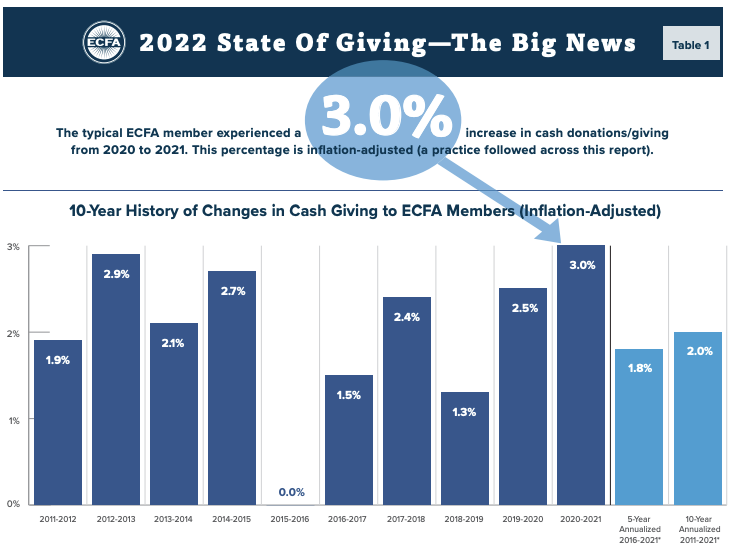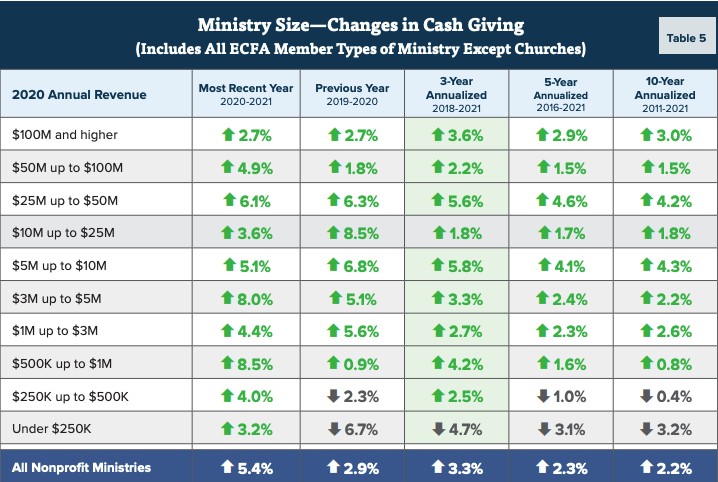Individual evangelical churches struggled financially much more during the COVID-19 pandemic than other kinds of ministries and nonprofits, leaders of the Evangelical Council for Financial Accountability revealed in a webinar hosted to unpack ECFA’s “2022 State of Giving” report.
“Unfortunately, churches of all revenue sizes saw a negative change from 2020 to 2021, with an overall negative change of 6.6%, almost equivalent to inflation,” said Jake Lapp, vice president of membership accountability for ECFA.

Jake Lapp
The biggest decline during that two-year period was reported by member churches with annual revenues between $6 million and $10 million, at 8.6%, according to the report. The next sharpest drop was for congregations that take in less than $2 million a year, at 8%.
But it was a much different story for various types of ministries and faith-based nonprofits, which saw increases in cash giving from 2020 to 2021 regardless of size, with an overall jump of 5.4%, Lapp said.
Organizations with annual revenues of $3 million to $5 million saw the largest increase from 2020 to 2021, at 8%. Those earning $100 million annually and those taking in less than $250,000 saw the smallest gains, at 2.7% and 3.2%, respectively.
But the most significant finding in the report, Lapp said, is that ECFA members, as a whole, reported a 3% increase in cash giving after adjusting for inflation. The report also found giving increases during the pandemic outpaced increases over the previous decade, including 1.3% from 2018 to 2019 and 2.5% from 2019 to 2020.

“It is the highest increase in the last 10 years when considering inflation was close to 7% in 2021. That means that cash giving grew by close to 10% before adjusting for inflation.”
Leading the way in cash-giving spikes from 2020 to 2021 were foundations, at 65.8%, and anti-human trafficking organizations at almost 30%, ECFA found. Pregnancy resource centers (14.5%), children’s ministries (12.6%) and church-planting ministries (12.2%) also saw significant increases in that period.
Along with churches, those experiencing declines were student and youth ministries (down 2.9%) and alcohol and drug rehabilitation organizations (down 2.7%).

Warren Bird
ECFA also polled 525 nonprofits and 87 churches in October to report on cash giving in the first three quarters of this year and to gauge attitudes about the 2023 financial outlook, said Warren Bird, senior vice president for research and equipping.
Almost half those respondents (48%) said contributions were higher from January to September 2022 than in the same period last year, while 36% said cash contributions have been lower and 16% said they are nearly the same.
More than half (57%) said they are optimistic about 2023, while 27% said they are uncertain and 16% said they are pessimistic.
The survey also asked members if their ministries experienced increased need for their services during 2022. Close to 80% said yes, and 71% added that inflation was part of the reason for that jump in demand.
According to the report, “More families and individuals are turning to food banks to help offset the cost of groceries, more people need counseling, and the number of homeless people seeking services is increasing. One ministry type seeing a high increase in needs is orphan care (100% reporting an increase in need) and rescue missions and homeless (93% reporting an increase).”
The 2022 survey also found 45% of ECFA members are struggling to find enough volunteers and 53% to find new staff. It also reported that 53% are having difficulty attracting new donors, and 63% are unable to attract major donors capable of giving gifts of $10,000 or more.
Despite those challenges, ECFA also learned that 33% of its member organizations plan to offer new types of benefits — such as flex hours or more days off — in 2023. The median cost-of-living increase those groups anticipate giving employees next year is 5.1%.
“That’s compared to 4.8% (pay increases) in 2022 and 3.4% in 2021,” Bird noted.

But during the pandemic, what happened in previous years was not a reliable predictor of what was to follow in giving trends, he said. “Only 55% of ECFA members that had experienced increases in cash giving in the two years leading up to the pandemic continued to experience increases during the pandemic. By contrast, 63% of ECFA members who experienced a decrease in giving by an annualized rate of 3% or more saw cash giving increase during the pandemic.”
Of note, the age of churches and ministries seemed to influence levels of cash contributions. “Organizations less than 10 years old have experienced annualized double-digit growth over the last five years including growth from 2020 to 2021, at 12.8%. This is more than double the growth rate of other age groups,” Bird said.

Nor are there clear-cut explanations of why churches took such a hit during the pandemic, Lapp said. “Congregations have been slow to return to the pews. Some churches are still reporting that they are only at 50% of attendance. I’ve even heard lower than 50% of attendance compared to pre-pandemic levels.”
If there is any takeaway from the report, it must include the imperative to be transparent with donors and to keep the promises made to them, Lapp said.
“One of the foundational principles of attracting and keeping donors is to convey that the ministry can be trusted. Donors want to hear stories of what’s happening in your ministry or church. They want to understand what they’re giving to. It’s important for ministries to communicate truthfully and then honor those purposes.”
Related articles:
Charitable giving bounces back in 2021 but more for secular than sacred causes
Despite financial hardships, Americans upped their giving to congregations during pandemic


